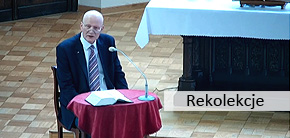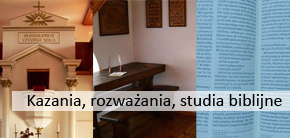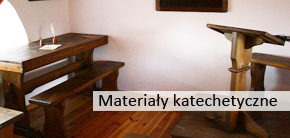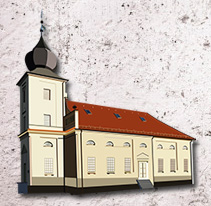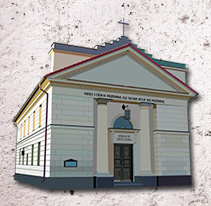The History of the Polish Evangelical Reformed Church
It should be pointed out from the start, that the history of Polish Reformed Christianity is somewhat complicated, as until 1945 there was never a single church entity but three. In fact, until 1849 there was no such thing as a Reformed Consistory. The three churches, called ’Brethren’ (’Jednoty’), had separate synods, different organisational structures and kept in contact through the “Synods General”, which were held only sporadically. This makes describing their history somewhat complicated.
The Polish Reformed movement goes back to the half of the 16th century when the teachings of Swiss Reformers like Zwingli and Calvin began to make their way to Poland. Earlier, Lutheranism had made way to Poland, especially in the cities. A great boost to the Reformation movement happened when in 1525 the devotedly Roman Catholic king Sigismundus I the Old (1506-1548) accepted as his vassal in East Prussia, the Lutheran prince Albrecht I Hohenzollern, thus creating the first Protestant country in the World. Though the king opposed “new thought”, humanists all across Poland and Lithuania (these were until 1795 one country) began studying Reformed theology. The most celebrated and influential group was found in the country’s capital Kraków, where they flocked around the book printer and vendor Jan Trzecielski (Jan Trecy) grouping nobles, burgers, professors, priests. The first Reformed church service was held in 1550 in Pińczów, a little town nearby Kraków, where the local noble owner converted to the Reformed Faith, expelled the monks, ’purging’ the city church. Other nobles soon followed suit and the first Reformed synod in Lesser Poland was held in 1564 in Słomniki, close to Kraków. Thus the Lesser Poland Brethren (Jednota Małopolska) was formed.
In the meantime in the North of Poland another Reformed church was formed. The Czech Brethren, persecuted by the Czech king Ferdinand I Habsburg fled to Greater Poland (1548), where they settled in the estates of the local aristocrats whom they very quickly converted to their faith. The number of their congregations quickly swelled from 20 in 1555 to 64 in 1570. Their main centre was the city of Leszno (Lissa), where they were settled under the patronage of the devotedly Reformed Leszczyński family. Thus the Greater Poland Brethren (Jednota Wielkopolska) also called the Czech Brethren, was formed. The Greater Poland and the Lesser Poland Brethren did try to cooperate more closely and even signed in 1555 a Union agreement but the Lesser Poland’s Reformed nobles who formed the bulwark of the church members found the Czechs too be too hierarchical and undemocratic and in the end the Lesser Poland Brethren became a strongly synodal structure, while the Greater Poland church became more Presbyterian.
The Reformation in the Grand Duchy of Lithuania (today’s Lithuania, Belarus, and Ukraine) date to 1552 when the local aristocrat Mikołaj Radziwiłł the Black received a Reformed preacher. Soon he was followed by his cousin Mikołaj Radziwiłł the Rufus and other aristocrats. The first synod was held in 1557, and two years later the Lithuanians signed a Union agreement with the Lesser Poland Brethren. A huge number of converts were attracted from Orthodox nobility. While the nobles used Polish in church services, an effort was made to convert the Lithuanian-speaking peasants and serfs, but since Lithuanian did not have a written form till the second half of the 19th century, Polish stayed as the official church language. Thus the Lithuanian Brethren (Jednota Litewska) came into being.
In 1556 John a Lasco (Jan Łaski) returned from Western Europe to help with the organisation of the Polish Reformed church. Seeing that the new king Sigismundus II Augustus was sympathetic to the Reformed cause, he tried to write a Confession that would be agreeable not only to all the three Reformed churches but to the Lutherans as well. Unfortunately exhausted from overwork he died in 1560, having achieved only the consolidation of the Lesser Reformed Brethren, which shortly afterwards was weakened by the split of the Unitarians (1563). In the same year the Second Helvetic Confession was translated to Polish and was adopted by the Lithuanian and Lesser Poland Brethren. Finally in a posthumous tribute to John a Lasco, the Czech Brethren, the Two Reformed and the Lutherans in Poland agreed in 1570 to the Confession of Sandomir (Konfesja Sandomierska), which was a irenic translation of the II Helvetic Confession and in theory formed one, united, Protestant church. The strength of the Polish Protestants was shown when in 1573 a law was passed foreboding any persecution based on religion, an act unprecedented in Europe of that time. The Protestants formed also over 65% members of the Lower and just about a half of the Upper houses of Parliament.
The Reformed opened excellent schools in Pińczów, Leszno, Kraków, Wilno, Kiejdany and Słuck, printed the first complete Bible in Polish.
Though grouping mainly nobles and aristocrats, in managed to have some following among the peasantry as well. In some regions the number of Reformed parishes completely outnumbered the Roman Catholic ones, though in proportion the movement probably never exceeded 20% of the total population and 45% of nobility.
{mospagebreak}
At the same time the movement was rising in strength, there were signs of Catholic revival. Jesuits were invited to Poland by the clergy in 1565, and these friars soon advocated more stringent methods of combating ‘heresy’. Religious riots followed, which managed to expel Protestants form the main cities of Poland (Kraków, Poznan, Lublin) with the important exception of Wilno. The Unitarian split seriously weakened the church, and in 1595 the Reformed – Lutheran Union fell apart. The new strongly Catholic king Sigismundus III Vasa, refused to promote any Protestants and from the beginning of the 17th century the church found itself in a serious defensive, with all three Brethren loosing churches and followers. The brief respite they got during the reign of king Wladyslaw IV Vasa (1632-1648), was followed by the disastrous civil wars, wars with Sweden, Russia and Turkey which ravaged the country for the end of the century. By then only a handful of faithful remained in all three Brethren, with the Lithuanian one now leading the other three. Nearly all the aristocrats have converted to Catholicism, and the last Protestant in the Senate (a Lutheran) died in 1668. The rise of intolerance began in 1660 when Unitarians were expelled from the country, and 1668 conversion from Catholicism was punishable by death. Finally in 1717 the Protestant nobility were stripped of all their political rights, with were only reinstated to them in 1768. Though a small number of Huguenots settled in Poland at the end of the 17th century (Gdansk, Warsaw), the numbers dwindled. The disaster of the three Brethren can be seen in the number of their congregations, given in the table below.
| Number of Congregations in 1591 | Number of Congregations in 1768 | |
| Lesser Poland Brethren | 250 | 7 |
| Greater Poland Brethren | 100 | 6 |
| Lithuanian Brethren | 200 | 27 |
The Polish Reformed from the beginning were staunch advocates of church unity, and what we would call today ecumenism. The Union of Sandomir, which united the Polish Reformed and Lutherans for 25 years, was followed by other initiatives. In 1607 one of the Reformed Superintendents from Lesser Poland wrote the treaty “Brotherly Rebuke”, published later in 1618 in Frankfurt in which he called for the unity of Christianity, the abandonment of names such as “Calvinist”, “Papist”, “Lutheran” and other and for a universal synod of Christendom that would end all divisions and schisms. His view were shared by a majority of the Lesser Poland Reformed clergy who singed his book in vast numbers. Though this particular initiative fell on death ears, in the course of the 17th and 18th centuries the co-operation between Protestants increased. In 1634 the Bohemian Brethren and Greater Poland Calvinists finally merged into one church; in 1675 the Lutherans and Reformed from Greater Poland signed a “friendly agreement” that carefully regulated common use of churches, defence against Roman Catholic clergy etc. Similar agreement have been signed earlier in Lesser Poland and the Grand Duchy of Lithuania.
{mospagebreak}
In 1768 under pressure from Orthodox Russia and Protestant Prussia the Polish Diet reluctantly reinstated political rights to Polish nobility, as well as granting nearly full freedom of worship and religion – only the prohibition of abjuring from Catholicism was maintained. Under the enlightened king Stanisław August Poniatowski (1766-1795), the Reformed quickly began to rebuild themselves from ruins. New churches in Poznań, Piaski etc. were constructed. In the capital Warsaw, a new congregation organised itself and erected a new church (1776). This congregation had a multicultural outlook, as apart from Polish nobles it consisted of merchants of Scottish, English, Swiss, French (Huguenot), Dutch and German origin. Services were held in Polish, German and French.
Church organisation also consolidated and in 1777 in the Lesser Poland’s congregation of Sielec, a union was signed between the Polish Reformed and Lutherans, and the Union of Sandomir was once again reaffirmed. A common Consistory was established with six members, in equal number from the Reformed and Lutherans, two being clergy, two being burghers and two being nobles. Though this union was short-lived (dissolved in 1782) the Protestants in Poland continued to grow and expand, especially in Warsaw, whose congregation soon overshadowed any other church centre. This optimistic period was cut short by the Three Partitions of Poland by Prussia, Russia and Austria (1772, 1793, 1795) which led to the disappearance of Poland for over a century from the map of Europe.
The beginnings were not easy. The Greater Poland Brethren was incorporated in 1817 to the Prussian Evangelical Union Church as a separate district but without any autonomy. Under constant pressure from the German government by the mid 19th century the United Church abandoned Polish in its liturgy and most of old Reformed nobles chose to convert to Roman Catholicism rather than to become Germans. In Austria too, the parishes were incorporated to the Austrian United Reformed and Lutheran Church. During the 19th century the number of Polish Reformed parishes shrank from 4 to just one in Kraków. There the Reformed shared the parish with Lutherans, and these became so dominant that from 1828 only Lutheran pastors were called to the pulpit, though a handful of Reformed survived.
Polish Reformed Christianity was maintained in land taken by Russia. The Warsaw congregation led by outstanding members dominated the rump Lesser Poland Brethren and became a leader of the denomination. The Lithuanian Brethren maintained its synodal structure and Polish outlook, and in the beginning of the 19th century erected a monumental church in Wilno (today Vilnius, in Lithuania).
The number of Reformed were growing too: in 1803 a colony of Czech settlers founded a town and congregation of Zelów. Under the energetic superintendent Karol Diehl (d.1831) in 1829 another administrative union was signed with Lutherans. Unfortunately, the predominance in the new Consistory of the Reformed over the more numerous Lutherans, as well as the unsuccessful November Rising in 1830 led the Tsar Nicolas I of Russia to dissolve the Union in 1849. Under the new decree separate Lutheran and Reformed churches were formed. The Lesser Poland Brethren was dissolved its six parishes merged into one (in Sielec) and now put under the charge of the Conisistory in Warsaw. This new church was called (unofficially) the Warsaw Brethren. The Lithuanian Brethren was spared dissolution, though its schools were taken away by the Russian state.
The rest of the 19th century saw a slow growth of the Reformed movement in Poland, though proportionally to the rest of the Polish population their percentage declined. New congregations were established in Lublin (1852), Sereje (1852), Suwałki (1852). The Czechs from Zelów migrated to other parts of Poland and there they formed new congregations: in Kuców (1852), Żyrardów (1852) and Łódź (1904). Despite severe Russian repression after the January Rising (1863) in which many Reformed nobles were implicated and active, the church remained Polish and slowly absorbed and Polonised new immigrant groups that settled in the country. The growth of the church would have been more impressive, had it not suffered from an acute shortage of ministers: for example in the 1880 there were just 5 pastors serving 10 congregations.
Things were not going so well for the Lithuanian Brethren. Its estates were confiscated in 1841 and after 1866 the church was forced to conduct its administrative business and synods in Russian. The number of congregations went down to 12, though 2 new were founded in the course of the 19th century by Czech settles from Zelów. The church managed to avoid any nationalistic conflict between its Lithuanian peasant members and the still predominant Polish nobles.
In the beginning of the 20th century a number of Polish Reformed from Żyrardów, Kuców, and Zelów emigrated to the United States were in 1915 a Polish Presbyterian Parish was formed in Baltimore, Maryland (it existed till 1941).
{mospagebreak}
Immediately after Poland regained its independence both the Warsaw and Lithuanian Brethren expressed joy at the occasion and a desire to unite in once church. Also, the Warsaw Brethren allowed in 1918 women full voting rights in the church assemblies, congregations and synods. Until the 1930s both churches grew rapidly.
The Warsaw Brethren organised new congregations in Toruń, Poznań, Lwów (toady Lviv in Ukraine) and Kraków. Due to missionary activity a few thousands of Ukrainians were converted to Reformed Christianity from Eastern Orthodoxy and organised into a semi-independent synod within the Warsaw Brethren. In 1926 the church started to publish a two-weekly church newspaper "Jednota" (Brethren) which still exists today.
The Lithuanian Brethren suffered huge loses, when the Lithuanian parishes formed themselves into a separate church in independent Lithuania, as well as the lost to Soviet Russia the old church centres such as Słuck, Kojdanów, Mińsk etc. The Brethren, now left with only 4 congregations (Wilno, Izabellin, Niepokojczyce, Michajłówka) rebuilt itself by incorporating Polish Anglicans (mainly converts from Judaism) into a separate synod, as well as by mission to Ukrainians and Byelarussians.
Despite repeated attempt to unite themselves, the two churches remained separate, and in the 1930s even hostile, after the Wilno Consistory engaged itself into a lucrative yet dubious business of granting easy divorces. Union talks were resumed in 1939 but were interrupted by the outbreak of the World War II.
By 1939 the Warsaw Brethren had over 20 000 members, and the Lithuanian Brethren ca. 5000 members. Apart from these two churches, the old Prussian United Church had ca. 3000 Reformed, and the old Austrian United Church ca. 2000, thus bringing the total number of Reformed in Poland to ca. 30 000 members. These included Poles, Czechs, Lithuanians, Germans, Ukrainians, Byelarussians, and Jews.
On September 1st 1939 Nazi Germany invaded Poland and on the 17th of September so did the Soviet Union. After desperate fight Poland surrendered by the end of the month. Both the Nazis and Soviets instigated a true reign of terror in the conquered territory. These measures affected also the Reformed.
In the Nazi sector the entire Anglican Synod of the Wilno Brethren (ca. 1000 members) was wiped out. In Łódź, the pastor was first forbidden to preach in Polish. When he started to do so in Czech, was arrested by the Gestapo after the Christmas Eve service in 1940, deported to Dachau where he was murdered. The congregation was suppressed and services ceased. The same happened to congregations in Toruń, Poznań and Lublin. The Warsaw parish survived under the courageous leadership of the General Superintendent Stefan Skierski (d.1948) but following the Warsaw Rising (1944), it was completely dispersed. Deportations, executions and forced labour decimated the church.
Under the “progressive” Soviets things were not better: the Ukrainian Protestants were deported and nearly completely wiped out. The Wilno congregation was first subjected to the Lithuanian synod, and then Polish services were ordered to cease. The nobility and intelligentsia were hunted down and either executed or deported to Siberia. By 1945 the Wilno Brethren ceased to exist. We survived this terrible ordeal only by the Grace of God.
It took the Polish Reformed two years before they met in a Synod (1947). The old Rev. Skierski was chosen again as superintendent but he died exhausted and broken by the atrocities of the war.
The situation of he church was dramatic: only three ministers were in Poland; the churches in Lithuania and Belarus were lost to Soviets; the church in Sielec, and Tabor were seized as “German” by the Catholic population; Warsaw was completely destroyed by the Germans, though miraculously the church survived. The number of members was estimated to be at 5000, so nearly 1/6 of that from 1939! Still, it was dropping even more, as the German and Czech Reformed were emigrating from Poland. Old Reformed churches in West Poland were taken over by the Catholics who refused to give them back; the lack of pastors was acute till the end of the 1950s. Some Polish Reformed stayed in the West rather than come back to a Communist regime and formed the London Reformed Polish Church, that existed till 1991.
The situation normalised a bit by the end of the 1950s when the church had finally organised itself into 9 congregations and 9 other “worship stations” where the Reformed joined the Lutheran congregations. However, the numbers were still dropping due to emigration to the West: for example the congregation in Strzelin dropped from ca. 1000 members in 1951 to 35 in 1995. The same happened in Żyrardów, Pstrążna and Żychlin. In the same time the little Polish Reformed Church became a well – know opponent of the Communist system. It was only in the 1980s that the number of members stabilised at ca. 3000 members and 9 congregations. It was also those years that saw the begging of the growth of our church. But that is no longer history but rather the present...











